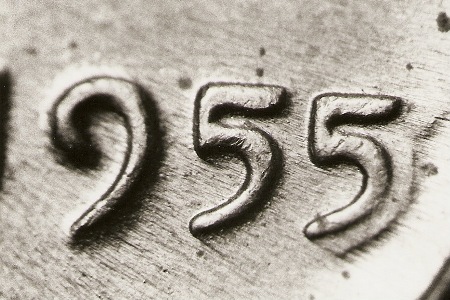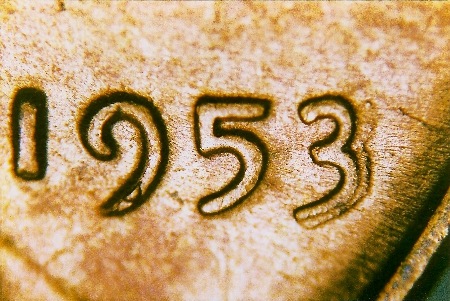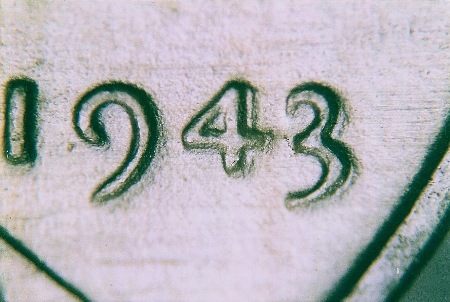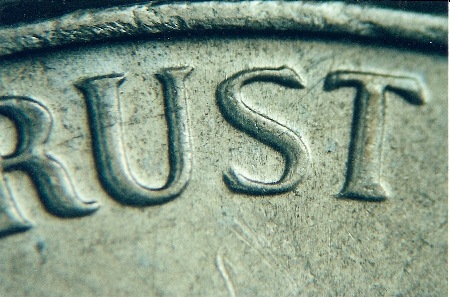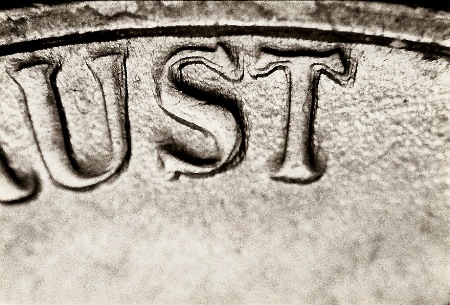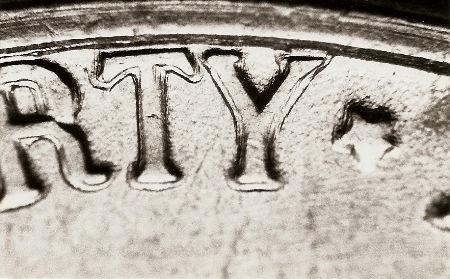


 |
 |
 |
 |
 |
 |
 |
 |
 |
 |
 |
 |
 |
 |
 |
 |
 |
 |
 |
 |
 |
 |
 |
 |
Die deterioration doubling is another form of common, worthless doubling found on U.S. coinage. Like mechanical doubling, it is frequently mistaken for the doubling that is seen on genuine doubled dies. Unlike mechanical doubling which is formed while the coin is being struck, die deterioration doubling is actually on the die itself. That is the one thing that it does have in common with genuine doubled die doubling. Die deterioration doubling results when the dies used to strike coins are kept in use for too long a period of time. As a die strikes coins, the impact of the die on the planchet forces the planchet metal into the cavities of the die to form the design that we see on the coins. Gradually, over a period of time, the flowing of the planchet metal into the cavities of the die will cause the surface of the die to erode much like a constant flow of water over an area of land will eventually cause the land to erode. Since the metal is flowing into the cavities of the die which form the design elements on the coin such as the letters or the bust, that is where the greatest stress and thus the greatest erosion will occur. This erosion of the die's surface will begin to form depressed areas around the letters and other design elements. These depressed or "incuse" areas on the die will form raised images on the struck coins. Since these additional raised areas are right around the letters and other design elements, they give the appearance of doubling to those design elements. True doubled dies generally show doubling in a single direction on the affected letters. On examples of coins with die deterioration doubling, you are likely to find that the doubling will be on both sides of the letters. Also, since dies showing die deterioration doubling are extremely worn, the affected letters or other design elements will have a mushy appearance as opposed to the crisp and distinct doubling usually seen on genuine doubled dies. Although die deterioration doubling can be found on Lincoln cents and older silver coins, it is much more frequently found on nickels and other coins in which nickel is part of the alloy. From 1965 on, all of our modern curponickel coins such as the clad dimes, quarters, half dollars, and dollars have nickel as part of the alloy for the clad outer layer. Nickel has proven to be a difficult alloy to strike into coins. The metal tends to resist flowing into the cavities of the die as easily as copper, silver, gold and some of the other metals used in a coin's alloy. This resistance to the normal flow of the metal produces a greater stress on the surface of the die causing the die to deteriorate more rapidly. As a result, die deterioration doubling is very common on our nickels and current clad coinage. With a little practice looking at some genuine doubled dies, and also looking at some examples of die deterioration doubling, you should be able to quickly tell the difference between the two. Serious collectors of doubled dies and other die varieties view die deterioration doubling as a form of damage to the coin. Knowing how it is caused you can readily see why. Consequently, it is deemed to have no collectible value. Once again collectors who are interested in adding genuine doubled dies to their collections need to be very careful and make sure that they are not being sold the wrong thing. I have seen a number of examples of supposed "doubled dies" being sold on Ebay or other on-line auction services where the photos of the doubling clearly show that the coin being sold has die deterioration doubling rather than genuine doubled die doubling. If you educate yourself to the differences between the two, you won't end up buying worthless coins for a premium. Likewise, if you are selling coins with doubling you have the responsibility to make sure that you are not accidentally misrepresenting what you are selling. My biggest pet peeve when it comes to die deterioration doubling has to be the so-called "1955 Poorman's Doubled Die." The 1955 Poorman's Doubled Die IS NOT A DOUBLED DIE! Let me repeat that! The 1955 Poorman's Doubled Die IS NOT A DOUBLED DIE! It is simply an example of die deterioration doubling and is very, very common and not worth any premium being charged for it. Whether you buy BU rolls of 1955 cents or circulated rolls of 1955 cents, if you search the coins in the roll you are almost certain to find several examples of this so-called die variety. Apparently during the mid-fifties the Mint made a habit of trying to stretch the life of the Lincoln cent dies and kept them in use too long. Doubling just like that seen on the so-called 1955 Poorman's Doubled Die can be found on cents dated 1953, 1954, 1955, 1956, and also 1957. Don't waste your money on any of these. Do a little searching and you'll find plenty for yourself without paying a premium for them.
This is a photo of the so-called 1955 Poorman's Doubled Die. It is not a doubled die! Rather, it is an example of die deterioration doubling and is extremely common.
The same type of doubling seen on the final 5 of the so-called 1955 "Poorman's Doubled Die" variety is seen here on the 3 of this 1953 Lincoln cent. You are not likely to see any ads advertising this one which is just as well since it is die deterioration doubling and not doubled die doubling.
This 1943 Lincoln cent also shows die deterioration doubling on the right side of the 4 and 3 in the date. We do not have many more examples of die deterioration doubling at this time. As we photograph more examples we will add more for you to study. Hopefully what you will see next will help you identify this form of "doubling."
The doubling seen in the photo above is genuine doubled die doubling as seen on the 2004-P Jefferson nickel doubled die variety that we have listed as 2004-P 5¢ WDDO-001. Compare it to the next photo which shows die deterioration doubling on the same letters of a 1960 Jefferson nickel.
The photo above shows die deterioration doubling on the letters of TRUST on a 1960 Jefferson nickel that was clearly kept in use for too long a period of time. Notice how the doubling on the T actually shows on both sides of the letter. Also notice how "mushy" the letters are in appearance.
Here we see genuine doubled die doubling on the RTY of LIBERTY on the 1950 proof Jefferson nickel that we have listed as 1954 5¢ Pr WDDO-002.
This is more die deterioration doubling on that same 1960 Jefferson nickel. Again notice how the doubling is on both sides of the letters and also notice the mushy appearance of the letters. Certain years and denominations are known for atypical, anomalous die deterioration. Die deterioration can appear and form differently as methods of die preparation, die steel quality, and tolerances for die wear have changed over time.
This is an example of unusual die deterioration on a 1971 Lincoln cent. This bead-like form of die deterioration (most visible on the vest southwest of the Y) is seen primarily on 1970-1971 cents, the exact cause of this unusual type of die deterioration doubling is yet to be determined.
Here is the date on the same cent. The outlining above the date, and the TY in the previous photo, was once believed to have been a doubled die. It was previously listed as 1971 1¢ WDDO-005 and was even included in the Cherrypickers' Guide as a DDO. Once this was found not to be a DDO, it was delisted by both authors.
This is a 2000-P Virginia quarter submitted by Eric Schmidt with strong doubling to the northeast on most of the obverse lettering on the right side. At first, the apparent split serifs are convincing enough to believe it may be a doubled die (this was briefly listed as WDDO-001). But the related doubling on the other elements tells a different story.
Looking elsewhere on this quarter, the doubling is not as convincing. Some areas show irregular doubling more typical of die deterioration doubling. And there is unusual die chipping in the lower relief areas of the hair behind the ear. This was simply a deceptive form of atypical die deterioration doubling. Click on the following links to see the information on: | ||


